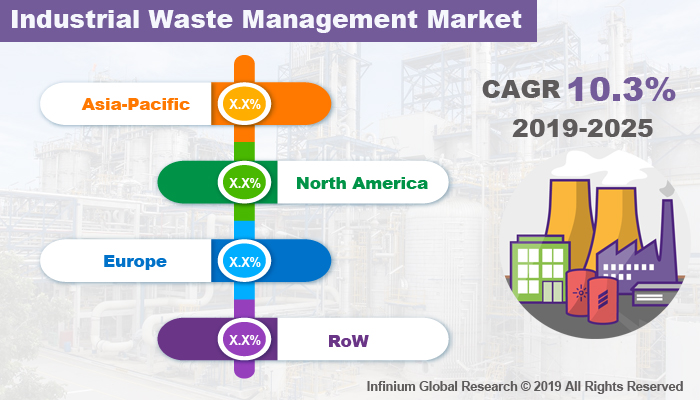Industrial Waste Management Market (Type - Agriculture Waste, Energy Waste, Chemical Waste, Mining Waste, Manufacturing Waste, and Other Types; Service - Collections, Recycling, and Landfills; End-users - Pharmaceutical, Aerospace and Defence, Pulp and Paper, Food & Beverage, Electronics, Biotechnology, Automobile, and Other End-users): Global Industry Analysis, Trends, Size, Share and Forecasts to 2025
A recent report published by Infinium Global Research on
industrial waste management market provides an in-depth analysis of segments and
sub-segments in the global as well as regional industrial waste management
market. The study also highlights the impact of drivers, restraints, and macro
indicators on the global and regional industrial waste management market over
the short term as well as long term. The report is a comprehensive presentation
of trends, forecast and dollar values of global industrial waste management
market. According to the report, the global industrial waste management market
is projected to grow at a CAGR of 10.3% over the forecast period of 2019-2025.

Market Insight
A recent study on the waste sector found that the majority of
businesses are moving waste up the hierarchy by concentrating on growing
recycling rates, better waste prevention, a greater focus on waste recycle,
setting zero waste to landfill goals, and energy recovery. Waste reusing and
recovery have become the focus of integrated waste management. Zero waste
strategy is used to manage waste from industries where all waste is diverted
from landfills and incinerators. Nearly all industries across the U.S. are
implementing new recycling programs and banning the use of particular products
and making a push for increased waste to energy. Acquisitions between smaller
waste removal companies are flattering a rising trend. It enables them to make
a greater impact on the industry and to compete against their larger
competitors.
Increasing demand for waste management solutions in developed
countries and growing urbanization and industrialization in developing
countries are the major factors driving the growth of the global industrial
waste management market. Furthermore, factors such as increasing awareness
about waste management in industries, technological developments in recycling
equipment and strict environmental regulations in developed countries are also
driving the growth of the market. However, the growing amount of industrial
waste and lack of initiatives by industries to reduce waste in developing
countries hamper the growth of the industrial waste management market.
Increased environmental awareness about renewable waste management systems
among people and worldwide growth in CO2 emissions are projected to provide
growth opportunities for the industrial waste management market.
Geographically, Asia-Pacific dominates the industrial waste
management market due to increasing adoption of waste management in industrial
applications. The waste generation is increasing in Asia-Pacific due to rapid
industrialization in the emerging countries that produces an enormous demand
for waste management services in the region. North America is one among the
fastest-growing market of industrial waste management followed by Europe.
Segment Covered
The report on global industrial waste management market covers
segments such as type, service, and end-users. On the basis of type, the
sub-markets include agriculture waste, energy waste, chemical waste, mining
waste, manufacturing waste, and other types. On the basis of service, the
sub-markets include collections, recycling, and landfills. On the basis of
end-users, the sub-markets include pharmaceutical, aerospace and defence, pulp
and paper, food & beverage, electronics, biotechnology, automobile, and
other end-users.
Companies Profiled:
The report provides profiles of the companies in the market such
as Stericycle, Inc., Waste Management, Inc., Sembcorp Industries, Veolia, Suez,
REMONDIS SE & Co. KG, Reclay Group, Daiseki Co., Ltd., Enviroserv Waste
Management (Pty) Ltd., Clean Harbors, Inc., SA Waste, and other companies.
Report Highlights:
The report provides deep insights into the demand forecasts,
market trends, and micro and macro indicators. In addition, this report
provides insights into the factors that are driving and restraining the growth
in this market. Moreover, The IGR-Growth Matrix analysis given in the report
brings an insight into the investment areas that existing or new market players
can consider. The report provides insights into the market using analytical
tools such as Porter's five forces analysis and DRO analysis of industrial
waste management market. Moreover, the study highlights current market trends
and provides forecast from 2019-2025. We also have highlighted future trends in
the market that will affect the demand during the forecast period. Moreover,
the competitive analysis given in each regional market brings an insight into
the market share of the leading players.
